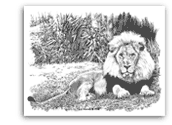AFRICAN
LION
#LYN-500
Notecards
Also available in Notecard Assortment Packs #AST-512
& #AST-513
#LE-LYN-500 Limited Edition Print
Known
as “the king of beasts,” African lions are the largest
of the African carnivores. Their habitat includes the grasslands
and semi-arid plains of sub-Saharan Africa. Lions play an important
role in keeping herbivore populations in balance with the plant
and water resources available.
The
only truly social member of the cat family, lions live for the
most part in groups called prides. A typical pride may be made
up of five or six adult females, two to four adult males, several
juveniles and cubs. While females in a pride usually remain together
for life, adolescent males are forced to leave as soon as their
fathers consider them potential rivals. The young males will spend
two or three years as nomads until they mature, then begin seeking
a pride to take over.
Females
do most of the hunting, relying on stealth, cunning and teamwork
rather than speed. Although males do hunt, they are not as fast
as females and their bushy manes tend to make them conspicuous.
Their main job is to guard the pride’s territory. Usually
hunting at night, lions spend up to 21 hours a day sleeping and
resting. Even though lions are reputed to be great hunters, many
hunts end in failure. Sometimes lions even steal food from other
predators, particularly hyenas whose excited whoops and hollers
let lions know for miles around that food is available.
Male
lions do not reach maturity until about five years of age. Their
distinctive manes begin to develop at about three years of age.
A mature male can weigh up to 550 lbs and measure four feet high
at the shoulder. Females reach maturity at about four years of
age and bear two to four young every two years. Lionesses within
a pride frequently enter breeding season together and later give
birth at the same time, allowing them to share nursing and other
maternal duties.
Text
© 1996 Dianne Harrah, Drawing © 1996 Bill Harrah
|

African
Lion
#LE-LYN-500
Limited Edition Print
Issue Date: 03/2002
Edition Size: 500
Image: 6.5” x 8.25”
Paper: 8.5” x 11”
Mat: 11” x 14”
$35.
View
matted print
|
|
Copyright
Notice
Drawings Copyright © 1992-2013 Bill Harrah, Wolf Run Studio (SM), All Rights
Reserved. Wolf Run Studio is a service mark of Bill Harrah and has been in continuous
use since 1992. All of the images on this website are in tangible form and are
fully copyrighted. Each has an invisible digital identification which is traceable
through the Digimarc Corporation. Viewers of the Wolf Run Studio website are
allowed to browse and print out images for personal, non-commercial use only.
You may not distribute copies of images or image files to anyone else for any
reason. Images may not be reproduced or used in any form or any manner, or displayed
on any website without the express written consent of Bill
Harrah.
Text Copyright
© 1992-2013
Terry White or
Dianne Harrah. Text on this website is used with permission from the authors.
Viewers of the Wolf Run Studio website are allowed to browse and print out text
for personal, non-commercial use only. Text may not be reproduced or used in any
form or any manner without the express written consent of the authors.
Information
Accuracy
The information for the written description of each animal has been carefully
researched by the authors and is believed to be accurate. New scientific observations,
however, could make some information out-of-date. If you are a professional
zoologist, and have new information that you are willing to share, please contact
Dianne Harrah .
|



